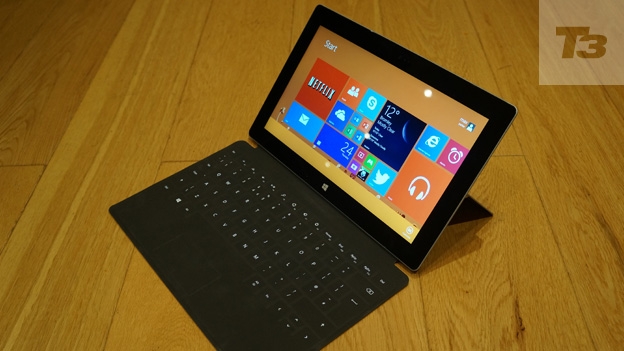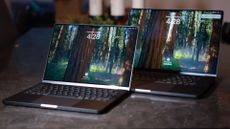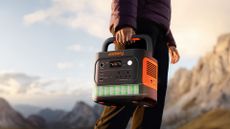Microsoft Surface 2 review
The Microsoft Surface 2 is the brand's second-gen Windows 8 tablet

-
+
Kickstand & keyboard combo
-
+
Vivid display
-
+
Useful multitasking
-
-
Barren Windows Store
-
-
Desktop mode
-
-
16:9 ratio not great on tablet
Why you can trust T3






The Microsoft Surface 2 is the brand's second attempt to take on the iPad, but does it offer enough to make it a worthy buy?
Update: The Microsoft Surface 2 Wi-Fi model has now been joined by an LTE-toting version. Check out our Microsoft Surface 2 4G review.
It's fair to say that the original Microsoft Surface didn't exactly set the world of tablet computing alight. Even though it had a unique kickstand, nifty cover that doubled as a keyboard and a free version of Office installed, it ended up costing Microsoft over $900 million.
Since the inception of the Surface, we've seen a slew of new tablets, including the slimline iPad Air, the iPad 4 and the S-Pen toting Samsung Note 10.1 (2014 edition), and they're just the 10-inch models. The 7-inch slates are also piling on the specs, with Google's Nexus 7 2 boasting a beautifully high-res display, nippy processor and a form factor that a catwalk model would be proud of.
So, here we are. A year later and with the tablet scene clearly hotting up, the maker is back with the Microsoft Surface 2, hoping things go a little more to plan this time around. First impressions are strong too; it clearly cares about this product. The screen's fantastic, the Tegra 4 processor flies and Windows 8.1 RT (yep RT is sticking around) seems to right many of the wrongs of its predecessor, but could it be your next tablet? Read on to find out.
Microsoft Surface 2: Size & Build
With its straight edges, strong lines and a lovely new silver colour, the Surface 2 is a real looker. It still has that industrial feel of its predecessor, but everything feels a bit more engineered this time around. The matte back is grippy, yet smooth and it's a joy to hold.
Microsoft has really made an effort to make the whole device much more manageable, though it weighs more or less the same as the original at 676g. The iPad 4 comes in 652g, while the Samsung Galaxy Note 10.1 (2014 edition) tips the scales at a much more impressive 540g. The new iPad Air however, is the lightest, weighing just 468g.
Seeing how much is packed into the Surface 2 though, it seems impressive Microsoft managed to keep the weight at what is it. This is down to the use of a VaporMg alloy, which is around three times lighter than aluminium - the material used in the iPad.
The chamfered edges, paired with curved corners make the Surface 2 comfy to hold, well for a fairly short period anyway. Settling down to watch a film was doable at first, though after a while we found the edges began to dig into our palms and became a bit uncomfortable.
Fear not though, Microsoft has kitted the Surface 2 out with a fantastic kickstand, a much improved version than we saw on the model from last year.
Whereas last year you were confined to one angle, a fairly rigid one at that, this year Microsoft has added a second, far more usable angle that instantly makes the device a much better product.
One area where last year's kickstand disappointed many was its lap use. Resting the Surface on your lap and trying to get some serious work done was almost impossible, it simply just bobbed around and lost all sense of balance.
Luckily 'lapability' (as Microsoft calls it) is a key feature of the Surface 2, all due to a second angle for the kickstand. When angled at 40 degrees (the other angle is 24 degrees) it sits much more rigid on your lap, plus it gives you a much improved view of the display for general usage.
Hidden under the kickstand is a useful Micro SD slot, which is joined by an even more useful USB 3.0 port. Continuing around the device you'll find a volume rocker switch, Micro HDMI, headphone jack, the power switch and a connector for the proprietary charging cable.
This magnetic port is particular finnicky and it's a pain actually fitting the charger in. Last port of call is another magnetic connection on the bottom; this is where you plug in the Touch Cover or Type Cover.
We tested our unit out with a Touch Cover, a thin keyboard and case combo that has been shrunk down to just 2.75mm thick. The cover clips into the Surface with a reassuring clicky noise and it stays attached even when you turn the device upside
When paired with the Office suite, this keyboard is one of Microsoft's key selling points for the device and it works well, though it really does take a while to get used to it.
At the start you'll be using the backspace key more frequently than any other and your spelling will be all over the place. The lack of a real reaction when you press the key doesn't help. Give it time though and it does become really useful. We also love the addition of a backlight, typing in the dark without it is not enjoyable.
One downside is the price, it costs £99 (the Type Cover will you back £109) which is rather pricey, though the Surface 2 feels oddly lost without it, because it's really the thing that sets it apart from the competition.
Microsoft Surface 2: Screen
Retaining the same 10.6-inch screen size as its predecessor, Microsoft has gone larger than the iPad (9.7 inches) and the Samsung Galaxy Note 10.1 (2014 edition) with its, er, 10.1-inch display.
While the size hasn't changed, the resolution most definitely has. The original Microsoft Surface had a middling 1366x788 display; the updated version though packs a really bright, vivid and detailed full 1080p screen, with a resolution of 1920x1080.
While it may not quite reach the levels of the 2048x1536 resolution display on the iPad Air, it's not that far off.
The Windows 8.1 tiled interface really pops, while HD movies also look brilliant. Text is crisp, though due to the 16:9 aspect ratio, reading books, in say the Kindle app, is not recommended. Turn the Surface 2 into portrait orientation and it becomes unwieldy. It's clear this is a landscape device.
Microsoft Surface 2: Camera
Microsoft has packed the usual dual camera set-up into the Surface 2, with a rear facing 5 megapixel snapper and a really impressive 3.5 mp version up front for Skype chats. These video calls look really good, much better than a FaceTime call between an iPhone, iPad and Mac.
Another tablet, another really average rear camera. It's safe to say you won't be ditching your digital compact or Nokia Lumia 1020 anytime soon. Snaps taken with the Surface 2 are serviceable, though it seems to struggle focusing and pictures were more often than not blurry. If you've got great light conditions you'll fare better, but only just.
Microsoft Surface 2: Sound
As we mentioned earlier, watching movies on the Surface 2 is great, thanks to its pin sharp 1080p display, though when watching a film, picture quality is just part of the story. You need punchy sound as well.
Setting the device in landscape mode, two stereo speakers, positioned at the top of each side, produce a good hit of volume, along with toned and clear sound. For a tablet it's probably one of the best, plus the speaker positioning means your hands won't get in the way, like they do on the iPad 4.
Microsoft Surface 2: Performance
Nestled under the VaporMg shell is a nice array of top performing internals, headlined by a NVIDIA Tegra 4 quad-core processor and paired with a healthy 2GB RAM. Performance is really snappy and so much improved over the original Surface.
Previously apps would take a good few seconds to open and they would hang on a very frequent basis. Thankfully that wait is gone and apps start almost instantly, running smoothly. When scrolling through T3.com in Internet Explorer, we were met with barely any stuttering or checkerboarding, a much welcome improvement.
Downloaded apps from the Windows Store seem to get the same treatment, though a few of these were a little slower than the native apps.
Games, the few that you can actually get, we'll get more into this later, run much better than before. The frame rate rarely drops and everything, well, just works.
In terms of storage space, the Surface 2 comes in two flavours - a 32GB and a 64GB option. We were reviewing the 32GB version, which has 25.3GB of usable space, however you only have about 17GB to play with - this is down to all the pre-installed software on the device.
While there is the option for Micro SD expansion, it's still a real annoyance that you have so little available space. Microsoft clearly wants you to use SkyDrive, as they give 200GB free for two years.
Microsoft Surface: Battery
Aside from price, one of the main reasons why you will most likely choose a tablet over a fully formed laptop is the increased battery life. Tablets have the ability to run for days, even with lots of usage and this is such a bonus.
Microsoft claims the internal battery on the Surface 2 should be good for 10 hours of use, while it should get fully juiced up again in a slight under four hours.
After testing the tablet for a while, we were inclined to agree with these statements and often we could go much longer without having to reach for the annoying proprietary charger. Standby times were equally impressive, if we left the tablet unused overnight, in the morning barely any battery would of depleted.
Microsoft Surface 2: Windows 8.1 RT
Everything has been pretty impressive so far. A nice, firm build quality, high-res 1080p display, useful keyboard cover and decent sounding speakers, along with a speedy processor, but it's not all good news.
The Microsoft Surface 2 ships with the latest edition of Windows, 8.1. Though unlike just about every other other Windows slate out there, including the Surface Pro and Surface Pro 2, the regular Surface ships with the RT version. The only other tablet that is currently being released with the software is the new Nokia Lumia 2520 - and Nokia is now a Microsoft company.
Windows 8 RT is meant to be streamlined and adapted for tablets, so you don't get access to legacy desktop applications, like Photoshop, that you get on the full version of Windows. This is fine, as in theory your app needs should be taken care of by the Windows Store.
Let's start with the positives though, because there are a few. The overall interface is really nice and it works well with the touchscreen. Large colourful tiles and glancable information combine to create a pleasant working environment that feels natural to use. 8.1 brings with it a number of additions, most notably is that everything is that bit stabler and speedier.
Integrated, system-wide Bing search is also a great feature, it's something you can work without, but once you've started using it, you miss it when it's no longer there. Multi-tasking is also a really impressive feature on the Surface 2 - we love just snapping two apps together and having them open at the same time.
Arguably the largest update for Windows 8 since launch, RT 8.1 comes with a focus on customisation allowing you to resize tiles with your mouse as well as a range of new customisation options for the Start screen.
From the positive, to the downright frustrating. Windows 8.1 RT still retains the desktop mode. This is, on the surface, a normal looking Windows PC interface, with the Start button at the bottom and a finder view.
There's also a range of mouse-friendly options now including the ability to right-click on tiles as well as being able to boot straight to desktop. Admittedly this will only be useful for apps like Office RT as they're the only apps that can truly work in desktop mode.
Word, PowerPoint, Excel and Outlook all work in this desktop mode and it's nice to have them available. Though the quicker they are updated to touch friendly versions the better.
Windows RT 8.1 is less of a step up than Windows 8.1 and it's almost entirely down to the limited functionality that RT offers in the first place. Mouse-focused updates are mostly useless for an OS that relies on almost all of its apps to run in the Metro tablet-friendly interface negating the need for a mouse pointer at all.
The customisation improvements are obviously very welcome and we like having the power and search buttons now available on Start, but any issues you had with RT remain, because well, it's RT.
Microsoft Surface 2: Apps
For a tablet, a device that heavily relies on apps, the Microsoft Surface 2 lacks in this area in a major way. Yes, the Windows Store has apps for Facebook, Twitter and Netflix, along with a couple of games like Asphalt 7 (Asphalt 8 has been out on iOS and Android for a while now) and Jetpack Joyride, but apart from that there's very little.
There's no GMail, no YouTube, no iPlayer, no Spotify, no SkyGo and that's just the tip of the iceberg. Apps like Paper, Garageband, iMovie and dJay 2, all of which make the iPad so appealing and creative are just so far ahead of the majority of Windows apps.
Yes, Office is here, but when you think the iPar Air has free apps for Pages, Numbers and Keynote, that doesn't sound quite appealing as it once did.
Unless all you plan on doing with the Surface is writing documents and creating presentations, you're going to feel the lack of things to do come in very quickly.
Microsoft Surface 2 4G review
The Surface 2 now comes with LTE capability in case you're tired of hotspotting it and fancy some date consumption on the go. Thankfully Microsoft has thought this addition through so aside from the added functionality you'll be hard-pressed to find many cosmetic differences between the two.
The SIM tray has been neatly positioned on the side with a push-to-open port giving access. It's unobtrusive and as well executed as in the iPad Air.
Setting up 4G is incredibly easy, simply pop in the SIM and the Surface will automatically register the network and get you up and running. Unsurprisingly speeds were almost instantaneous and we had no isssues watching Netflix, streaming YouTube and browsing the web all on the move.
Where things could have got dicey is in the battery life, but surprisingly the Surface 2 LTE doesn't suffer from a noticeable dip in battery life at all. While we found heavy data usage did drain the battery a little faster than normal the overall standby times were as impressive as the Wi-Fi-Only model.
It's clear that the LTE version adds a tonne of functionality, especially on the move, the question you'll need to be asking yourself though is 'is it really worth the price'. It's a question you should definitely be asking as well considering the LTE version only comes with 64GB of storage so will set you back £539, as opposed to the Wi-Fi-only version which costs £439.
Microsoft Surface 2: Verdict
The Microsoft Surface is a good tablet that improves on almost everything from the last model, however it is not a great tablet. The 16:9 aspect ratio makes it feel unwieldy when you pick it up and we barely used it except when the kickstand was flipped open and it was on a table.
The lack of apps is killer, even though the OS itself is really nice to use and Windows has come such a long way from the now unspeakable days of Vista. Having the full blown Office suite is great, but this tablet needs more.
It's just that the Surface 2 is lost in between laptop and tablet, doing neither as well as it probably could do. The keyboard cover is good, but it is nothing more. One day, hopefully, Microsoft will find a way to combine the Windows Mobile 8 OS and Windows 8.1 RT, so that apps will more freely available and you can buy once and use everywhere, but until then this just won't be mainstream product.
Microsoft Surface 2 price: £359 (32GB), £439 (64GB), £539 (64GB + 4G) | Touch Cover £99, Type Cover £109
Microsoft Surface 2 release: Out now
Additional reporting by Tom Tamblyn
Sign up to the T3 newsletter for smarter living straight to your inbox
Get all the latest news, reviews, deals and buying guides on gorgeous tech, home and active products from the T3 experts
-
 Here's when the first OLED MacBook Pro might become available
Here's when the first OLED MacBook Pro might become availableBut don't hold your breath just yet
By Britta O'Boyle Published
-
 Netflix's new thriller shows how scary some schools can be
Netflix's new thriller shows how scary some schools can beWe get a tiny glimpse of Wayward
By Max Freeman-Mills Published
-
 New Jackery power stations will power your explorations
New Jackery power stations will power your explorationsThe improved portable power stations are a perfect pick for outdoorsy folk
By T3.com Published